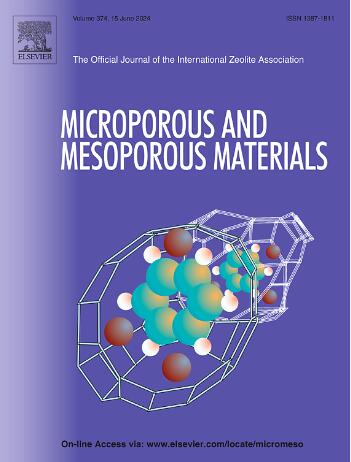动态切换CTAB作为唯一模板,通过简单的常规静态水热法合成分层多孔ZSM-5
IF 4.7
3区 材料科学
Q1 CHEMISTRY, APPLIED
引用次数: 0
摘要
目前,仅以十六烷基三甲基溴化铵(CTAB)为模板构建分层多孔ZSM-5分子筛是分子筛合成领域的一大挑战。本研究以CTAB为唯一模板剂,从CTAB包封的硅胶球前驱体中提取,通过简单的传统静态水热法合成了具有分层孔结构的ZSM-5分子筛。通过控制二氧化硅球的溶解速率,调节CTAB的释放速度,使纯相分级多孔ZSM-5分子筛的合成成为可能。考察了碱度、老化时间、硅铝比、CTAB含量、添加方式、结晶时间等因素对ZSM-5分子筛结构的影响。实验结果表明,该体系的结晶过程顺序为:MFI→MFI +肯雅石→MFI +石英。此外,通过对结晶过程的控制,我们系统地考察了杂质的形成过程,并确定了在该体系中合成纯相分层多孔ZSM-5分子筛的最佳条件。此外,制备的分层多孔ZSM-5分子筛在MTP反应中对轻质烯烃的选择性增强。本文章由计算机程序翻译,如有差异,请以英文原文为准。

Dynamic switch of CTAB as the sole template for the synthesis hierarchically porous ZSM-5 through a straightforward conventional static hydrothermal method
At present, the construction of hierarchically porous ZSM-5 molecular sieves using only cetyltrimethylammonium bromide (CTAB) as the template represents a major challenge in the field of molecular sieve synthesis. In this work, hierarchically porous ZSM-5 zeolite was synthesized via a straightforward conventional static hydrothermal method, employing CTAB as the sole template agent derived from CTAB-encapsulated silica sphere precursors. By controlling the dissolution rate of silica spheres, the release rate of CTAB is regulated, enabling the synthesis of pure-phase hierarchical porous ZSM-5 zeolite. The influences of alkalinity, aging time, Si/Al ratio, CTAB content and addition method, and crystallization time on the construction of hierarchically porous ZSM-5 molecular sieves were examined. The experimental results indicate that the crystallization process in this system proceeds in the order: MFI → MFI + kenyaite → MFI + quartz. Additionally, by managing the crystallization process, we systematically examined the formation process of impurities and established the optimal conditions for synthesizing pure-phase hierarchically porous ZSM-5 molecular sieves in this system. Moreover, the as-prepared hierarchically porous ZSM-5 molecular sieves demonstrated enhanced selectivity towards light olefins in the MTP reaction.
求助全文
通过发布文献求助,成功后即可免费获取论文全文。
去求助
来源期刊

Microporous and Mesoporous Materials
化学-材料科学:综合
CiteScore
10.70
自引率
5.80%
发文量
649
审稿时长
26 days
期刊介绍:
Microporous and Mesoporous Materials covers novel and significant aspects of porous solids classified as either microporous (pore size up to 2 nm) or mesoporous (pore size 2 to 50 nm). The porosity should have a specific impact on the material properties or application. Typical examples are zeolites and zeolite-like materials, pillared materials, clathrasils and clathrates, carbon molecular sieves, ordered mesoporous materials, organic/inorganic porous hybrid materials, or porous metal oxides. Both natural and synthetic porous materials are within the scope of the journal.
Topics which are particularly of interest include:
All aspects of natural microporous and mesoporous solids
The synthesis of crystalline or amorphous porous materials
The physico-chemical characterization of microporous and mesoporous solids, especially spectroscopic and microscopic
The modification of microporous and mesoporous solids, for example by ion exchange or solid-state reactions
All topics related to diffusion of mobile species in the pores of microporous and mesoporous materials
Adsorption (and other separation techniques) using microporous or mesoporous adsorbents
Catalysis by microporous and mesoporous materials
Host/guest interactions
Theoretical chemistry and modelling of host/guest interactions
All topics related to the application of microporous and mesoporous materials in industrial catalysis, separation technology, environmental protection, electrochemistry, membranes, sensors, optical devices, etc.
 求助内容:
求助内容: 应助结果提醒方式:
应助结果提醒方式:


